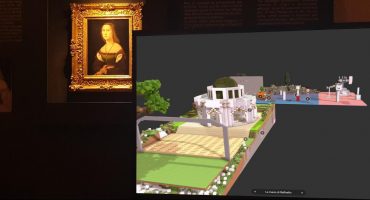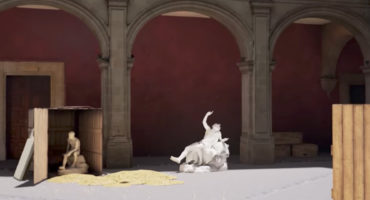This post is by community member Hannah Rice, published by Sketchfab staff.
Hello! My name is Hannah Rice, I am currently training to become an archivist and my passion is bringing built heritage to (digital) life combining polygon modelling and archives. I have an MSc in Digital Heritage and a BA in History of Art, both from the University of York.
My enthusiasm for 3D started over 20 years ago as a young gamer and eventually I decided to combine my love for old buildings and digital worlds by learning how to create my own. As a buildings historian I am interested in visualising places from the past and present, their architectural forms and conveying this information to others using 3D.
My 3D workflow typically starts away from the computer. It begins in an archive where I research and gather material to inspire and inform the creation of my 3D models. Archives are not the stereotypical dark and dusty dungeon-like buildings often portrayed in videogames, but are treasure troves that connect us with our past working to collect, preserve and promote our documentary heritage. Archives form a wonderful resource of primary sources, some dating hundreds of years old, all which I use to research a 3D model subject, from architectural plans to photographs, illustrations and first-hand accounts in correspondence and journals.
Researching a historical building in the archives is an enjoyable, but essential, part of the model creation process. It is like a jigsaw puzzle where you piece together a picture of what a building looked like at one point in time. I usually gather material that will help me form an idea of scale, building materials, colour and architectural style. Whilst in the archives I obtain digital copies (with copyright permissions) of the material I will directly input into my 3D modelling software, Blender, as a background image to model against. This is usually a digital file of a ground plan or elevation drawing, or perhaps a historical illustration. If the building is still standing today, I will often visit the site to take photographs for use as textures.

Modelling against an elevation drawing, Hotham House, Eastgate, Beverley ©Hannah Rice
Within Blender I will input my background images gathered from my research and use a technique called polygon modelling to manipulate the mesh from a simple cube to an un-textured model that represents my historical building. I will then add materials to the building combining UV maps with my own photographs or textures I have created in Photoshop, all informed by historical sources describing what the building was constructed from. I will then upload the model to Sketchfab, and create some additional renders which will be edited further within Photoshop to create a snapshot of my building from a particular period in time.

Work in progress model of 17th-century Hull based on Wenceslaus Hollar’s view of Hull c.1642 (top). ©Hannah Rice
I consider myself as an artist who interprets historical sources and creates a model based on my findings. Sometimes I find I have to make modelling decisions informed by my own buildings history knowledge if the research does not provide an answer to how an architectural feature looked, such as window style or brickwork patterns. My visualisations are more interpretative and quite different to creating an exact scientific representation which you can achieve with photogrammetry.
Most of my work takes inspiration from the built environment of places I have a connection to, either through the local area of the East Riding of Yorkshire or my ancestry. I am half Cornish so my model of St Michael’s Chapel at Roche Rock near St Austell, Cornwall is quite meaningful to me as my ancestors’ lived in the area.
3D is taking an ever-increasing role in the world of heritage, particularly in museums, however it is fairly new ground in archives as our collections are based on paper, parchment and digital media. 3D can be used as an effective tool for heritage interpretation within the archives sector.
In my work capacity as an Archives Assistant at the East Riding Archives I facilitated a series of workshops called ‘Archives in 3D’ based on teaching participants how to create digital models in Blender using our collections as inspiration. These were fun-filled sessions based on recreating the historical architecture of Hull and East Riding from the medieval and Tudor periods. During the workshops we created models with reference to documents such as Wenceslaus Hollar’s map of Hull, ground plans of Beverley Gate (Hull) and building plans of some of our grand country houses.
The aim of the workshops was to show that anyone can have a go at 3D modelling and to demonstrate the creative application of archives to digital heritage work which you can share on the web, or within animations, videogames and even 3D-printed. The applications can be wide with models being suitable for use for educational or entertainment purposes.

‘Archives in 3D’ participants using archive collections to create their own 3D model. Photos used with kind permission from the East Riding of Yorkshire Council.
Whilst we are producing models, the archivist in me is always thinking about the legacy of what we create. The digital preservation of 3D models is one of many challenges the archives sector is currently facing with obsolescence of software and hardware being a huge threat to our digital heritage. Digital media is known to be more ephemeral and volatile than paper-based material, which have lasted centuries without much intervention. Will our 3D models be accessible in 10 years’ time? I’d like to think so! The future is looking positive as archivists are currently implementing their digital preservation plans to make our digital models available for generations to come.
Sketchfab contains lots of brilliant cultural heritage models, from photogrammetry to polygon modelling, and one of my favourite cultural heritage collections to follow is Bart’s collection of 3D paintings I think it’s a great way to immerse yourself within the worlds these artists had created in ways which they would never have considered. I particularly like being able to experience the iconic works of Salvador Dali and M C Escher from different perspectives as it gives a new dimension to surrealism.
You can follow Hannah on Twitter at @ArchivistH and her Sketchfab profile.



